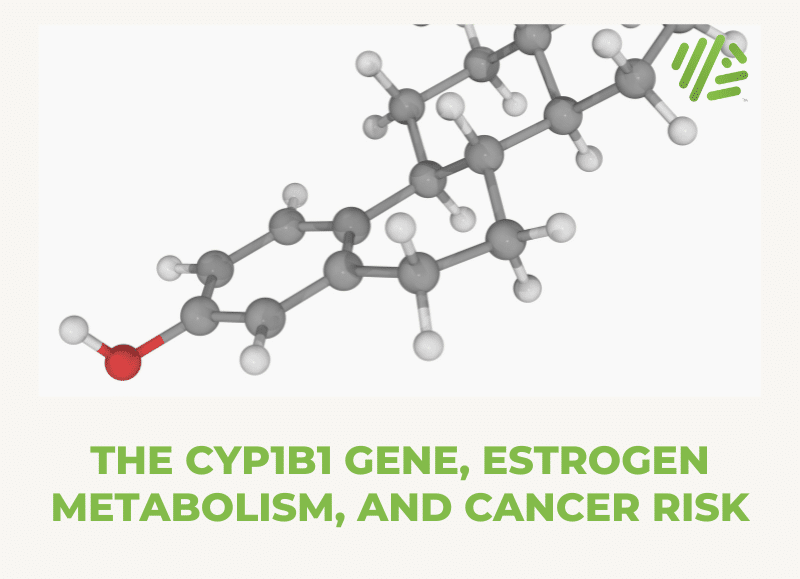The CYP1B1 Gene, Estrogen Metabolism, and Cancer Risk

Contents
Perhaps you just did some genetic testing and noticed a “mutation” in your CYP1B1 gene.
What does this mean? Does it increase your risk for breast cancer? How should changes in this gene impact diet and lifestyle, if at all?
This post contains discussion on the role of single nucleotide polymorphisms (SNP), alleles and genes within the CYP1B1 family.
Estrogen, the sex hormone
Estrogen is one of the two major female sex hormones, although it is also present in men in smaller amounts. Estrogen is produced mainly in the ovaries, as well as in fatty tissue, and in the adrenal glands, which are the source of estrogen in men. Estrogen is essential for the development and regulation of the female reproductive system, and is key in modulating the menstrual cycle.
As such, synthetic estrogen is often present in birth control medicines, where it acts to prevent ovulation (although estrogen free variants are available).
Dietary sources of estrogen
Most dietary estrogen comes in the form of phytoestrogens, or plant-derived estrogens. Phytoestrogens can both mimic and block normal estrogen activity. This dual function has meant that dietary phytoestrogens are often associated with both positive and negative health and nutritional benefits, often to confusing effect.1
Foods rich in phytoestrogen include flax and sesame seeds, oats, barley, hops and lentils and most importantly soy and its derivatives including tempeh and tofu. 2
The pros and cons of dietary phytoestrogens are discussed elsewhere; however, in this post we are focusing on the changes in estrogen metabolism arising from alterations in the CYP1B1 gene.
The CYP1B1 gene explained
The Cytochrome P450 (CYP) gene family provides instructions to produce a wide range of enzymes involved in drug metabolism, synthesis of cholesterol, steroids, and other lipids. One family member, the CYP1B1 gene, encodes the enzyme cytochrome P450 1B1 (called the CYP1B1 protein going forward) that plays a role in the metabolism of estrogen.
While severe disease-causing mutations in the CYP1B1 gene are associated with glaucoma and other eye anomalies,3 common variations in the gene, known as single nucleotide polymorphisms (SNPs – pronounced ‘snips’), have generated much interest within the scientific community for a very different reason.
Different SNPs in the CYP1B1 gene may explain the variability, between individuals, in enzymatic activity of the CYP1B1 protein, and therefore its ability to metabolize estrogen.
So why does it matter how well an individual metabolizes estrogen?
Too much estrogen can be a problem
Too much estrogen is not always a good thing. While estrogen is essential for the development and regulation of the female reproductive system, as well as cholesterol regulation and bone health in both men and women, too much estrogen may increase the likelihood of developing breast cancer over a lifetime. 4
Of the Cytochrome P450 enzymes, the CYP1B1 enzyme has the highest levels of estrogen hydroxylation activity and expression levels in breast tissue. CYP1B1 metabolizes estradiol (a form of estrogen known as E2) to form 4-OH-estradiol and other metabolites. 4-OH-estradiol has been shown to induce carcinomas.
Any changes in the CYP1B1 gene sequence in the form of SNPs, which have the potential to change the activity of the CYP1B1 enzyme, and therefore the amount of 4-OH-estradiol, may also have implications for lifetime cancer risk.5
Implications for variations in the CYP1B1 gene
The SNP rs1056836 (C/G) is located within exon 3 of the CYP1B1 gene, which results in the substitution of a leucine (L) amino acid for a valine (V) amino acid at position 432 of the protein ( hence L432V). Leucine is encoded when the ‘C’ allele is present in the codon at position 432, whereas valine is encoded when the ‘G’ allele is present.
There is significant variation in the population frequency of the CYP1B1 L432V SNP as shown in the table below:
| CYP1B1 -rs1056836 | Overall (%) | African American (%) | Caucasian (%) | Chinese (%) | Japanese (%) |
| CC (Leu/Leu) | 489 (38) | 20 (7) | 233 (33) | 116 (78) | 120 (74) |
| CG (Leu/Val) | 525 (40) | 115 (40) | 338 (49) | 31 (21) | 41 (25) |
| GG (Val/Val) | 280 (22) | 154 (53) | 124 (18) | 1 (1) | 1 (1) |
Table Adapted from Sowers et al., 2006.
Those homozygous for the C allele (both copies of their gene contain C) will produce CYP1B1 protein containing leucine, whereas those homozygous for the G allele with produce CYP1B1 protein containing valine. Those heterozygous i.e. they carry a C and a G allele will produce both types of protein.
CYP1B1 proteins containing either leucine or valine are both functional; however, several studies have demonstrated that the enzymatic activity of CYP1B1 containing valine (‘G’ allele) is 2 to 3 times greater than that of CYP1B1 containing leucine (‘C’ allele), although this data was generated in lab based studies.67 This enhanced enzymatic activity of CYP1B1 would result in an increase in the metabolism of estradiol to 4-OH-estradiol, with a potential increase in the risk of developing cancer.
Based on these findings it was hypothesized that those carrying the G allele, and especially homozygotes (GG) may display enhanced estrogen metabolism, with an associated breast cancer risk.
However, two subsequent studies investigating the effect of the CYP1B1 L432V SNP in women did not find any association with estrogen, or estrogen metabolite concentrations. Sowers et al., investigated CYP1B1 polymorphisms in menopausal women and their association with estradiol and estrogen metabolites. Whilst they detected significant variations in population frequency for the CYP1B1 L432V SNP they did not detect any significant differences in estrogen or estradiol metabolism resulting from these changes.8
Similarly, Tworoger et al., investigated the CYP1B1 L432V SNP on post-menopausal women. As with Sowers et al., they did not detect any significant association between the CYP1B1 L432V SNP and estrogen or estradiol metabolism.9
However, they did note that the CYP1B1 L432V SNP only impacts on protein activity in the presence of two other CYP1B1 polymorphisms specifically rs10012 (R48G) and rs1056827 (A119S).10
Importantly, this was a small study featuring only 5 women in an Ethiopian population and a similar study investigating the role of these three SNPs in a Polish population did not find any link with the development of cancer.11
Estrogen supplementation
Based on the current scientific literature the CYP1B1 L432V SNP is not associated with any alterations in estrogen or estradiol metabolism, suggesting that supplemental estrogens, such as those found in birth control medicines, would have no impact on health or cancer risk.
However, there is some data suggesting that CYP1B1 L432V in association with R48G or A119S may alter estrogen metabolism. Based on the study size and outputs investigated it is not possible to determine if those carrying these polymorphisms are at an elevated risk of developing cancer, or if estrogen supplementation will impact on this risk.
A later study investigating multiple CYP1B1 SNPs and their influence on the development of breast cancer did not find any association, however the study did not investigate R48G or A119S.12 Taken together these findings suggest that CYP1B1 SNPs play a limited, if any, role in the development of cancer. The occurrence of positive results in small sample sizes suggests CYP1B1 SNPs may be associated with other much stronger environmental or unknown genetic risks of cancer development.
Whilst dietary phytoestrogens can have an impact on the function of CYP1B1 gene expression and protein function there is no evidence of any association with CYP1B1 SNPs 1.
Take Home Message – Breast Cancer Link Not Established
There was initial interest in the role of CYP1B1 L432V SNPs in the metabolism of estrogens and the development of cancer due to proposed differences in CYP1B1 enzyme activity.
However, recent large scale studies in patients have demonstrated no evidence that the CYP1B1 L432V SNP is associated with an elevated risk of cancer. Therefore, supplemental estrogen taken either through dietary sources or in the form of birth control medicines is unlikely to impact on general health and wellbeing, or significantly increase cancer risk.




Aaron,
Does a CYP1B1 L432V GG homozygous SNP cause over-hydroxylation (less total Estrogen and more metabolites) or under-hydroxylation (more total Estrogen and less metabolites)?
Hi Matt,
My reading is that L432V GG homozygous will increase the hydroxylation. However, the studies showing this were lab-based, so it’s not clear if this would carry over into the body.
Hi Aaron, could you let me know the study that confirms recent large scale studies in patients have demonstrated no evidence that the CYP1B1 L432V SNP is associated with an elevated risk of cancer, as I would like to look into this in relation to Salvestrol.
http://www.orthomolecular.org/library/jom/2006/pdf/2006-v21n01-p34.pdf .
Hi Angela, this is the link here:
https://www.ncbi.nlm.nih.gov/pmc/articles/PMC3547044/
Taken from their abstract:
“We can conclude that the rs10046 polymorphism on CYP19 by itself does not constitute breast cancer risk. We cannot, however, reject the possibility that it could contribute (interact), together with other genetic variants, to modify the circulating levels of estradiol.”
That second sentence is very important, as how this polymorphism interacts with known BC associated mutations would be worth knowing.
Also just to add, salvestrols are new to me. Is there any particular reason you’ve become interested in them?